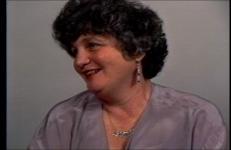
This section comprises taped interviews with artists, architects, musicians, critics and other creative practitioners, recorded in conversation with Video Data Bank staff, colleagues from the School of the Art Institute faculty, and others knowledgeable about the particular interviewees work.
The first interview dates from 1976, the year of VDB’s official inauguration, and VDB continues to add to the collection to this day, recording and producing approximately ten new interviews a year. Many of the interviewees are guests of SAIC departments, such as the Visiting Artists program or Conversations at the Edge screening series, or invitees of the Society for Contemporary Art. The VDB interviews supplement these visits, allowing for an in-depth conversation that underlines the development of an artist's practice.
Steve Kurtz is a founding member of the Critical Art Ensemble and Associate Professor of Art at University of Buffalo. His areas of focus are contemporary art history and theory as well as post-studio practices. As a student Kurtz collaborated with Steve Barnes on low-tech videos, which they developed into a broad-based artist and activist collective known as the Critical Art Ensemble.
Interview by Gregg Bordowitz.
A historical interview originally recorded in 1999 and re-edited in 2005.

Elizabeth LeCompte is the director of the Wooster Group, an experimental theater company that operates out of its own theater, the Performing Garage, in New York City. The group’s working process begins with "source" texts which are quoted, reworked, and juxtaposed with fragments of popular, cultural and social history, and combined with personal and collective experiences of the group. The resulting productions reflect a continuing refinement of a non-linear, abstract aesthetic that at once subverts and pays homage to modern theatrical "realism."
Interview by Lin Hixson.
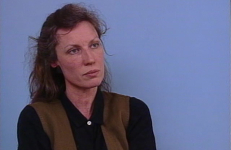
During a conference in the late 1970s, Carol Leigh (also known as the Scarlot Harlot) coined the term “sex worker.” Now, it is a fundamental part of the lexicon regarding all worker’s rights and this is owed in large part to Leigh’s artistic and activist career. Working primarily through the medium of performance and video – her work attempts to educate and broaden audiences’ understanding of sex work and the fundamental rights sex workers deserve. This interview is a distillation of those aims.
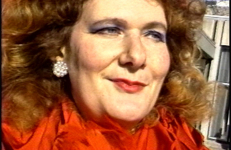
Thai conceptual performance video artist Kamin Lertchaiprasert (b.1964) anchors his work through a commitment to the core principles of Buddhism and his definitive goal to create “life-specific” rather than “site-specific” art. For Lertchaiprasert, the purpose of art is to reclaim the meaningfulness of human activities and collaboration. The artist describes how his techniques of production and his choice of medium ranges from environmental works, to formal sculptures made from recycled materials, to the use of relational aesthetics in the creation of collaborative workshops. With reference to cultural and religious differences between East and West, Lertchaiprasert also posits how the philosophy of art under Buddhist ideals can be a matter of survival, helping us to better understand the essence of being alive. -Faye Gleisser

Linda Montano is interviewed by Janet Dees, Curator at the Mary and Leigh Block Museum, Northwestern University.
Since the 1960s, Linda Montano has aimed to blur the distinction between art and life with her performance and video work. Delving deep into subjects like death, spirituality and personal trauma, she is seen as an influential figure in feminist performance art.
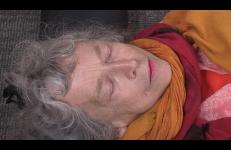
Sharon Lockhart is a photographer and filmmaker. Her photographic and filmic works interrogate the inversion of the static image as cinematic and the manipulation of the moving image into a static/stop-motion frame. Her work also contemplates how we perceive our own real-time realities.

Awarded a MacArthur “Genius” Fellowship in 2014, Rick Lowe is a leading practitioner of social practice art. His Row Houses project is a highly lauded example of relational aesthetics successfully deployed. This interview focuses particularly on that work and the artist’s entrance into social practice.
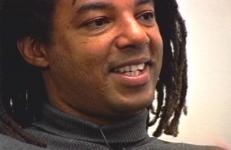
In this 2013 interview, experimental animator and School of the Art Institute of Chicago alumna Jodie Mack discusses the developments that have taken her from an interest in musical theater and playwriting to organizing microcinemas and DIY filmmaking.
Mack describes her interest in early cinema history and the relationship between its technologies and spectacle, particularly the manner in which video production incorporates planned obsolescence. Referring to the “scavenger nature” of her work, Mack discusses her interest in waste and her desire to use reclaimed materials in her work. Using fabric and paper to create shifting fields of color, Mack references corroded and glitched digital media in her work. Her use of quotidian materials reflects upon the role of abstract animation in everyday life, and serves to draw audience awareness to the spectacle of televisual technology.
– Kyle Riley
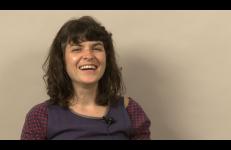
Sara Magenheimer earned her MFA at Bard in 2013 and has since shown her work internationally in Canada, Iceland, the Czech Republic, and Denmark. Her cross-disciplinary practice plays with the juxtaposition between the form and content of language, exposing the absurdity of expected meanings.

Born in 1987, Ibrahim Mahama is an artist and author who creates monumental installations out of materials originating from Ghana, Mahama's home. Described in The Guardian as "a junkyard utopian", he investigates the conditions of supply and demand in African markets, often making work with materials like cocoa and jute sacks.
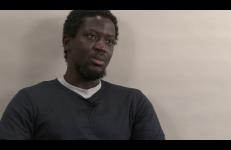
John Malpede is a performance artist and Director of the Los Angeles Poverty Department (LAPD), a performance art and theater group whose members include the city’s homeless. Through LAPD, Malpede provides an opportunity for homeless people to articulate the reality of their lives for themselves and audiences. Malpede was well known for his collaboration with performer Gill Gordh as Dead Dog and Lonely Horse. In one performance he took on the role of a street person, contrasting the wealth and excess of the 1984 Olympics in Los Angeles with the city’s struggle against homelessness.

In this 1996 interview, African-American sculptor, printmaker and designer Valerie Maynard (b.1937) describes growing up in Harlem in the mid-20th Century and her awareness of the importance of community during her upbringing. Recalling the prominence of the Baptist church in her early life, Maynard discusses how religion brought her into contact with local politicians who impressed upon her the importance of affecting change. The artist notes how an early affiliation with Congressman Adam Clayton Powell and her brother’s incarceration propelled her interest in social justice and the workings of the judicial system.
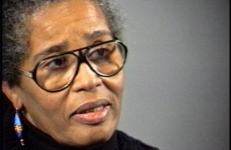
Laura Mulvey published her seminal essay "Visual Pleasure and Narrative Cinema" in 1975; it has subsequently become one of the most influential work in film theory. Using a psychoanalytic methodology to discuss spectatorship, it was groundbreaking in its feminist critique of the sadistic, misogynistic mode of classical Hollywood cinema in which women were objects of fetishistic display for male viewers’ pleasure. She has also written extensively on melodrama, published three books, and co-directed six films, including Riddles of the Sphinx with Peter Wollen (1974).
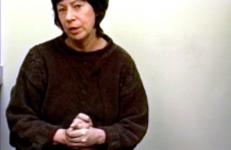
In this interview, American writer, artist, performer Eileen Myles (b.1949) discusses the various philosophies that motivate her work, including the language of film, embodied performance, and the alienation evoked by bodily vulgarity. Myles links her wide range of artistic and literary practice with notions of abstraction, improvisation, and the mythology of gender, which she explores in relation to her own identity as a working, middle-class lesbian woman. She reflects on the significance of geographical locations, both New York City and San Diego, on her art, and shares how her past struggles with addiction have shaped her life and practice.
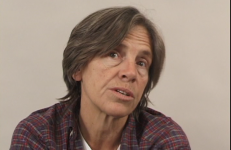
In 1973 Joan Nestle co-founded the Lesbian Herstory Archives, an essential collection of documents, writings, and artifacts of lesbian cultural history. In 1979 she began writing erotic stories and has published two collections of writings: A Restricted Country (1987) and A Fragile Union (1998). She took a controversial stance in opposition to the 1980s feminist anti-pornography movement, thus becoming a fervent pro-sex activist in the “Sex Wars.” Interview by Nina Levitt.
